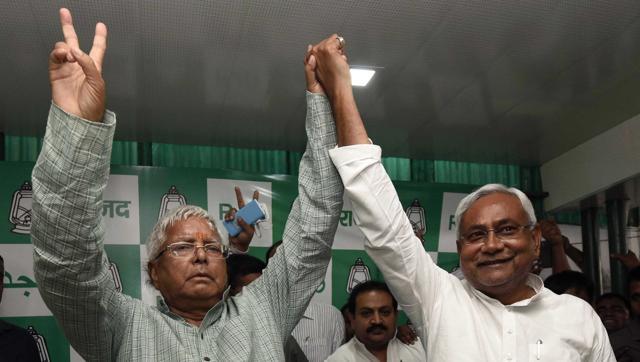In what came as a fateful culmination to a bitter prelude, Nitish Kumar was sworn in as Chief Minister of Bihar for the fifth consecutive turn on the 20thNovember, Friday. This culmination, which actually is the commencement of an interesting yet potentially bitter power equation between erstwhile foes and now (apparently) beloved brothers, Lalu and Nitish, deserves few quick takes. Firstly, the Bihari voter is less gullible than he was a few years back, and is more willing to reward the incumbent for good governance. Secondly, for all the talk of development, Lalu’s score shows that caste equations are still biased and status quo does not correspond with caste equity. Thirdly, the cow does not carry you through elections; at least not so yet.

PTI Photo
The Bihar loss has certainly harmed the image of the PM as the origin of some eternal election-winning wave. On the other hand, the opposition is highly likely to make a misguided derivation of legitimacy for its obstructionist policies. Discussing the loser becomes important over the short run. The markets have cooled down and whatever little global hysteria did exist over Bihar among the financiers and the media has been liquidated by the concern over awardwapsi on the one hand and amazement over the crowds at Wembley on the other.
The conduct of the winner though, has long term implications on two fronts. The first is the possibility of a consolidated and credible force of opposition to the present Government, effecting a shift in the contours of political formation that have influenced national politics till date. The second is the aspiration and hope with which the Bihari voter has voted, in turnouts that reflect his belief in the electoral system to hand him returns.
In view of prevailing on these two fronts, there indeed is a case for Lalu-Nitish to maintain their brotherhood in letter and spirit. The ideals that the two purport to stand for are not conflicting. Rather, they are deeply entwined so much so that going by one will elucidate the other.
Bihar faces crises that cannot be left to the Market. It is plagued by deficient investment, heavy supply constraint, lack-lustre infrastructure and a corrupt beaurocracy. Bihar is also plagued by serious crises on the social front, crises that compound the roadblock to living up to its true economic potential.
Bihar has literacy rates of 51.9% and 71.2% for females and males respectively, relative to figures for India as a whole, that stand somewhere at 65.5% and 82.1% respectively. The schools are plagued by severe crisis of absenteeism, teacher shirking, under-average performance and lacking educational infrastructure, to extents far higher than their national averages. Findings from the India Human Development Survey 2010, (in line with an all-India survey by ACER more recently), also indicate the largely dismal state of educational quality in the state. The achievements on the healthcare front are no better. The proportion of undernourished children under five is roughly 55%, while corresponding figure for Sub-Saharan Africa is 20%. What is lost in the averages is data for districts and villages in Bihar that well may further validate Bihar consisting for few of the most economically and socially deprived regions, the world over. Though data documented here is from the 2011 census and some sources of the same year, even calculating a mean rate of growth for these indices and producing newer numbers does not attract major celebration, since these numbers do not come too close to numbers for many states and to the national average. This points to a real and present crisis of healthcare and education.
An educated and healthy population is not only an asset in attaining growth, rather, it is very much the instrument. A population as this makes conditions conducive to development of better administration and economic exchange. For e.g., China substituted its regressive labour regime with a contractual labour system wherein the labourer enters into a contract with the employer. This couldn’t have been possible back in the 1980s, but with a population that was 95% literate. Similarly, the shrinking of productive potential caused by a labour plagued by malnutrition, disease, and poor health may not reflect quantifiably when viewed from a microeconomic perspective, but makes a statistically greatly significant yet not exactly quantifiable difference in aggregation. A more educated and healthy population is more likely to recognize and show willingness in self-interest to stand up to corrupt practice in administration, thus smoothening the implementation of policy.
A capitalist order cannot attain perfect competition, this is rather cliche to economics students. However, this in no manner implies that the market must be allowed to operate as perfectly as possible, in those sectors that the government must allow it to, if free markets are going to be the stated aim. An uneducated and unhealthy population distorts such a market as much as poor infrastructure and transport facilities do. It restricts the talent pool and imposes heavy restraints to occupational mobility of labour. Typically, growth elasticities of poverty reduction (reduction in number of poor with every percentage point of increase in growth) are found to be greater in states with better education and health indices. Lesser poverty is favourable to long term demand.
Thus, Nitishbhai’s stated aim of better growth and better incomes is attained. To be sure, Nitish Kumar has been investing in development of human capital, and there is evidence to suggest that his investments have indeed resulted in growth in education and health statistics. There thus, is a case for these investments to continue, without being disrupted by some recent growth models that may seek to sideline such policies.
Relegating caste divisions to be a non-issue, as seems to have become the trend days, is a blunder. Bihar constitutes the ‘heart’ of the so-called ‘Hindi Heartland’, and caste patterns are visible indeed. From separation of children by caste during mid-day meals, staunch opposition to inter-caste exchange and enduring lower caste subjugation is very much the reality. More educated and healthy populations are barely the antidote to caste. Caste, on close observation appears to prevail in even urban, middle class settings. However, a more educated and healthy population does lead to empowerment. Lower castes, when empowered; show a greater likelihood to opposing caste divisions in public spaces, because the question is one of inherent human dignity. Education breeds awareness, and internal constraints of inferiority among lower castes can thus evaporate. At the end of the day, the surest means of annihilating caste is empowering the lower caste to demand dignity through initiation of social reform. Such empowerment is a process of which reasonable reservations are part. Thus, educated and healthy lower caste populations that have opportunities for employment in the regular formal sector shall be where the long battle for social justice begins. Equality, at the end of the day is a social decision, not an economic decision. Thus, a politician can get only so far, beyond which we need a statesman.
So long as Lalubhai chooses to be one, his narrative is also vindicated.
There is, thus, clear intersection between the narratives of Lalu and Nitish. The game is partially, if not totally, a cooperative one, because both stand tor values that are mutually reinforcing, and both stand to gain by beginning (rather, persisting) with education and healthcare.
As for the cow, the poor cow shall bask in her holiness until the BJP is convinced of the restraints to her bovine ilk in electoral matters.
Bihar or not, development must not be viewed from a narrow income perspective. It must be viewed as the extent of choice and the extent of internal and external freedom in exercising it. Prominent contemporary economists and Nobel laureates, Amartya Sen and Angus Deaton, build a compelling and robust case in their transformative work, to support this perspective. Governments in all developing and underdeveloped states must cede to bow to ‘unaimed opulence'(as Prof. Sen puts it) and recognize evidence from economics, history, comparative statistics and logic to prioritize this multidimensional nature of development, a sustainable model of which can stand only with responsible public allocation to income support, free education and healthcare to the most vulnerable, who frequently tend to be the most deprived yet unheard majority.








